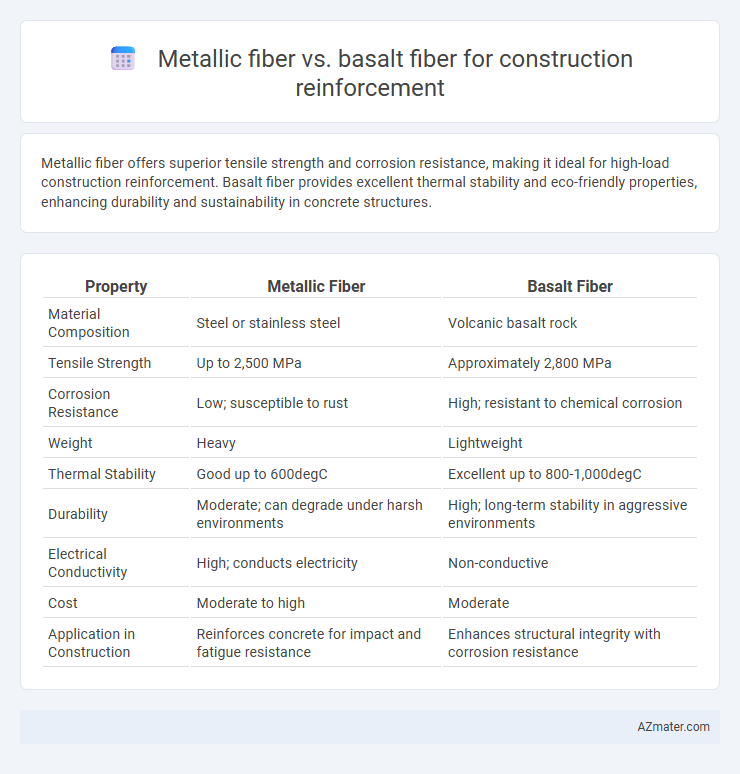Metallic fiber offers superior tensile strength and corrosion resistance, making it ideal for high-load construction reinforcement. Basalt fiber provides excellent thermal stability and eco-friendly properties, enhancing durability and sustainability in concrete structures.
Table of Comparison
| Property | Metallic Fiber | Basalt Fiber |
|---|---|---|
| Material Composition | Steel or stainless steel | Volcanic basalt rock |
| Tensile Strength | Up to 2,500 MPa | Approximately 2,800 MPa |
| Corrosion Resistance | Low; susceptible to rust | High; resistant to chemical corrosion |
| Weight | Heavy | Lightweight |
| Thermal Stability | Good up to 600degC | Excellent up to 800-1,000degC |
| Durability | Moderate; can degrade under harsh environments | High; long-term stability in aggressive environments |
| Electrical Conductivity | High; conducts electricity | Non-conductive |
| Cost | Moderate to high | Moderate |
| Application in Construction | Reinforces concrete for impact and fatigue resistance | Enhances structural integrity with corrosion resistance |
Introduction to Metallic and Basalt Fibers in Construction
Metallic fibers, typically made from steel or stainless steel, provide exceptional tensile strength and ductility, enhancing the durability and crack resistance of concrete structures. Basalt fibers, derived from volcanic basalt rock, offer high thermal stability, corrosion resistance, and lightweight reinforcement, making them suitable for aggressive environments and long-term structural integrity. Both fibers improve concrete's mechanical properties, but metallic fibers excel in impact resistance while basalt fibers are preferred for sustainable, corrosion-resistant construction applications.
Composition and Manufacturing Processes
Metallic fibers, typically made from steel or stainless steel, consist of iron alloys offering high tensile strength and durability, manufactured through processes like wire drawing and cutting into short fibers. Basalt fibers originate from volcanic basalt rock, melted at approximately 1,400degC and extruded into continuous fibers, providing excellent thermal resistance and corrosion stability. The manufacturing of basalt fibers involves melting raw basalt rock and direct extrusion, which is more environmentally friendly compared to the complex alloying and mechanical processing required for metallic fibers.
Mechanical Properties Comparison
Metallic fibers, often made from steel or stainless steel, provide high tensile strength and excellent impact resistance, making them ideal for enhancing concrete's flexural and deformation capacity. Basalt fibers exhibit superior corrosion resistance, lower density, and moderate tensile strength, with better durability in chemically aggressive environments compared to metallic fibers. Mechanical property comparison highlights that metallic fibers deliver higher modulus of elasticity and ultimate tensile strength, while basalt fibers offer improved fatigue resistance and reduced thermal expansion, influencing the choice for specific structural reinforcement applications.
Durability and Corrosion Resistance
Metallic fibers provide high tensile strength but are prone to corrosion, especially in aggressive environments, reducing their long-term durability in construction reinforcement. Basalt fibers exhibit excellent corrosion resistance and maintain structural integrity when exposed to chemicals, moisture, and saltwater, resulting in superior durability for reinforcement applications. The inherent non-metallic composition of basalt fibers ensures prolonged lifespan and reduced maintenance compared to metallic fibers in harsh construction conditions.
Flexural and Tensile Strength Analysis
Metallic fibers exhibit superior tensile strength, often exceeding 1000 MPa, providing enhanced structural flexibility and crack resistance in concrete reinforcement. Basalt fibers, with tensile strengths typically ranging from 2000 to 3000 MPa, offer excellent corrosion resistance and maintain durability under high-temperature conditions, making them ideal for long-lasting reinforcement applications. Flexural strength analysis indicates that metallic fibers improve impact resistance and energy absorption, while basalt fibers contribute to increased stiffness and reduced deformation under bending loads.
Fire Resistance and Thermal Performance
Metallic fibers, such as steel fibers, offer high tensile strength but have limited fire resistance due to their conductivity and potential for deformation under extreme heat. Basalt fibers provide superior fire resistance and thermal stability, maintaining structural integrity at temperatures exceeding 800degC (1472degF). These characteristics make basalt fibers more suitable for construction applications requiring enhanced fire protection and thermal performance.
Environmental Impact and Sustainability
Metallic fibers, mainly steel, have high embodied energy and contribute significantly to carbon emissions during production, while basalt fibers, derived from volcanic rock, offer a lower carbon footprint and are non-toxic and recyclable. Basalt fibers improve sustainability in construction by reducing resource depletion and enhancing durability without heavy environmental costs associated with mining and steel processing. Their natural abundance and lower energy-intensive manufacturing make basalt fibers a more eco-friendly reinforcement alternative compared to traditional metallic fibers.
Cost Effectiveness and Availability
Metallic fiber offers high tensile strength and excellent durability, but its cost is significantly higher compared to basalt fiber, making it less cost-effective for large-scale construction projects. Basalt fiber is derived from abundant natural volcanic rock, providing a more economical and readily available alternative with good mechanical properties and corrosion resistance. The widespread availability of basalt fiber results in lower supply chain costs and makes it a preferred choice for budget-conscious construction reinforcement applications.
Application Suitability in Construction Projects
Metallic fibers, known for their high tensile strength and excellent conductivity, are suitable for applications requiring enhanced structural toughness and crack resistance in concrete slabs, pavements, and industrial flooring. Basalt fibers offer superior corrosion resistance, thermal stability, and chemical inertness, making them ideal for harsh environments such as marine structures, bridges, and tunnels where durability and longevity are critical. The choice between metallic and basalt fibers hinges on project-specific demands like exposure conditions, load requirements, and environmental factors, with basalt fibers favored for sustainability and metallic fibers preferred for heavy-duty reinforcement.
Conclusion: Choosing the Right Fiber for Reinforcement
Metallic fiber offers superior tensile strength and ductility, making it ideal for heavy-load-bearing construction applications requiring enhanced durability and crack resistance. Basalt fiber provides excellent corrosion resistance and thermal stability, suited for structures exposed to harsh environmental conditions or where chemical inertness is critical. Selecting between metallic and basalt fibers depends on specific project demands such as load requirements, environmental exposure, and longevity expectations, ensuring optimal reinforcement performance and cost-effectiveness.

Infographic: Metallic fiber vs Basalt fiber for Construction reinforcement
 azmater.com
azmater.com